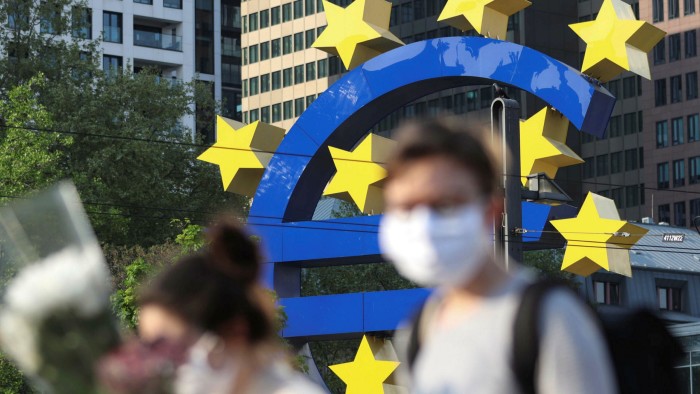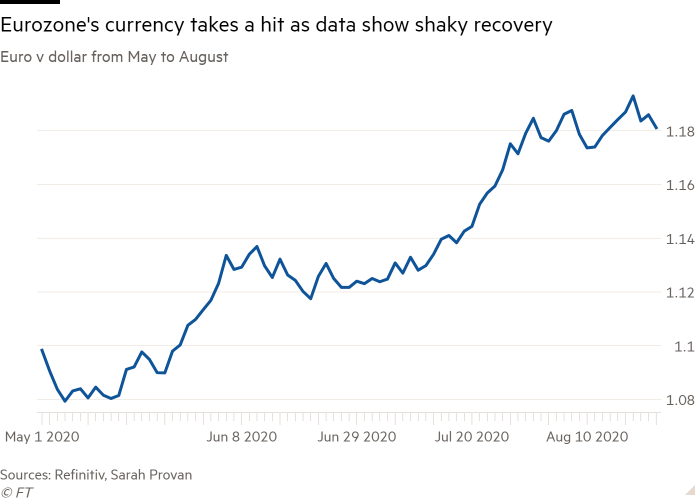Fresh jolt of Brexit uncertainty knocks sterling versus dollar

Simply sign up to the Currencies myFT Digest -- delivered directly to your inbox.
The pound and euro sunk after negotiators on both sides of the English Channel warned of a lack of progress in Brexit talks, and after eurozone regional data showed an economic recovery losing momentum.
Sterling took a hit after Brexit negotiators gave a gloomy assessment of the latest round of EU-UK talks, with the UK’s representative admitting “little progress” had been made.
A deal “will not be easy to achieve”, said UK chief negotiator David Frost, noting that “time is short for both sides”. Michel Barnier, his EU counterpart, said “the clock is ticking” and added that the UK “must come with clear, constructive proposals” to the next round of Brexit talks.
“We have had useful discussions this week but there has been little progress,” Mr Frost said in a statement on Friday, after the two sides concluded their seventh round of talks.
The single currency declined 0.6 per cent against the dollar to $1.179 after survey data showed a rebound faltering in the eurozone, spearheaded by the bloc’s two biggest economies. The figures raised questions about the strength of the bloc’s recovery in the third quarter.
Friday’s drop in the euro against its US counterpart barely dented a sharp rally for the currency in recent weeks, which came after EU leaders agreed a bloc-wide rescue package and the dollar came under broad selling pressure. The euro, which has risen about 10 per cent against the dollar since March, sealed its first weekly decline in nine weeks.
There was “a clear sense of concern over the near-term outlook for the economy”, said MUFG’s Derek Halpenny before the figures were released and after the European Central Bank said on Thursday that there was “no room for complacency”.
Stocks in Europe endured a choppy session as Friday’s figures set the tone for the view on the continent’s economic recovery. The Stoxx Europe 600 and the FTSE 100 both reversed mid-morning gains to slip 0.2 per cent by the close.

Technology stocks such as Apple were once again outperformers on Wall Street. The S&P 500 closed at a record high for a second straight day, up 0.3 per cent to 3,397.16, having also set a new intraday record of 3,399.96, and the tech-heavy Nasdaq Composite rose 0.4 per cent,
A fourth straight week of gains for US equities was founded on “generally constructive consumer stock earnings, a very strong housing market, and a still-supportive Fed set against evidence of diminishing business sentiment,” said Goldman Sachs analysts. “Investors cannot afford to wait for the resolution to a problem (the virus) that they know will be resolved (with a vaccine or treatment).”
The pound accelerated an early decline to pull away from the dollar by 0.9 per cent, trading at $1.3090, but held relatively steady against the euro. One euro bought 90.09p.
The pound has had a particularly topsy-turvy week, posting on Wednesday its biggest one-day drop in two months, while a day earlier its 1 per cent rise became its largest daily gain since June 1. Those sharp moves put it on track to be barely positive for the week, up 0.1 per cent against the dollar.
Data in the UK revealed a robust response to coronavirus-related initiatives as retail sales and business activity pointed to a sharp upswing in the economy, in stark contrast to the eurozone.
“The slight uptick in retail consumption may help ease concerns over the fragility of the UK economy — but not for long,” said Alistair McQueen, head of savings and retirement at insurer Aviva. “A rapid recovery still seems a long way off.”
Shares in the Asia-Pacific region rebounded after a rally in technology stocks had buoyed Wall Street, even though signs appeared of worsening US unemployment and manufacturing activity.
Hong Kong’s Hang Seng index rose 1.3 per cent while China’s CSI 300 index of Shanghai- and Shenzhen-listed stocks rose 0.9 per cent. Japan’s benchmark Topix index was 0.3 per cent higher.
Comments